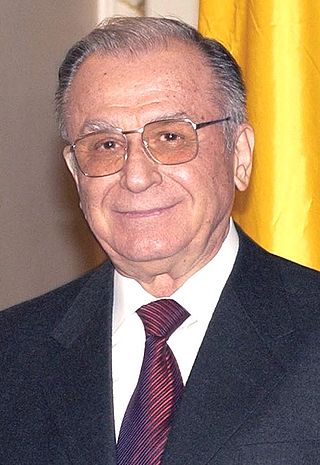
Ion Iliescu is a Romanian politician and engineer who served as President of Romania from 1989 until 1996 and from 2000 until 2004. Between 1996 and 2000 and also from 2004 to 2008, the year in which he retired, Iliescu was a senator for the Social Democratic Party (PSD), of which he is the founder and honorary president to this day.
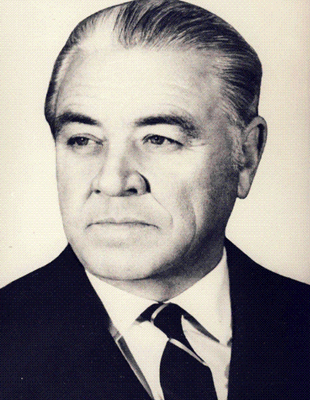
Ion Gheorghe Iosif Maurer was a Romanian communist politician and lawyer, and the 49th Prime Minister of Romania. He is the longest serving Prime Minister in the history of Romania.

Chivu Stoica was a leading Romanian Communist politician, who served as 48th Prime Minister of Romania.

The Romanian Communist Party was a communist party in Romania. The successor to the pro-Bolshevik wing of the Socialist Party of Romania, it gave an ideological endorsement to a communist revolution that would replace the social system of the Kingdom of Romania. After being outlawed in 1924, the PCR remained a minor and illegal grouping for much of the interwar period and submitted to direct Comintern control. During the 1920s and the 1930s, most of its activists were imprisoned or took refuge in the Soviet Union, which led to the creation of competing factions that sometimes came into open conflict. That did not prevent the party from participating in the political life of the country through various front organizations, most notably the Peasant Workers' Bloc. During the mid-1930s, due to the purges against the Iron Guard, the party was on the road to achieving power, but the dictatorship of king Carol II crushed this. In 1934–1936, PCR reformed itself in the mainland of Romania properly, with foreign observers predicting a possible communist takeover in Romania. The party emerged as a powerful actor on the Romanian political scene in August 1944, when it became involved in the royal coup that toppled the pro-Nazi government of Ion Antonescu. With support from Soviet occupational forces, the PCR pressured King Michael I into abdicating, and it established the Romanian People's Republic in December 1947.

Vasile Luca was an Austro-Hungarian-born Romanian and Soviet communist politician, a leading member of the Romanian Communist Party (PCR) from 1945 and until his imprisonment in the 1950s. Noted for his activities in the Ukrainian SSR in 1940–1941, he sided with Ana Pauker during World War II, and returned to Romania to serve as the minister of finance and one of the most recognizable leaders of the Communist regime. Luca's downfall, coming at the end of a conflict with Gheorghe Gheorghiu-Dej, signaled that of Pauker.

Grigore Preoteasa was a Romanian communist activist, journalist and politician, who served as Communist Romania's Minister of Foreign Affairs between October 4, 1955, and the time of his death.

Miron Constantinescu was a Romanian communist politician, a leading member of the Romanian Communist Party, as well as a Marxist sociologist, historian, academic, and journalist. Initially close to Communist Romania's leader Gheorghe Gheorghiu-Dej, he became increasingly critical of the latter's Stalinist policies during the 1950s, and was sidelined together with Iosif Chișinevschi. Reinstated under Nicolae Ceauşescu, he became a member of the Romanian Academy.

Ion Dincă was a Romanian communist politician and Army general who served as Deputy Prime Minister and Mayor of Bucharest under the Communist regime.
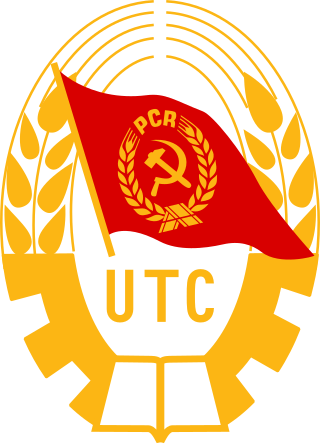
The Union of Communist Youth was the Romanian Communist Party's youth organisation. Like many Young Communist organisations, it was modelled after the Soviet Komsomol. It aimed to cultivate young cadres into the party, as well as to help create the "new man" envisioned by communist ideologues.
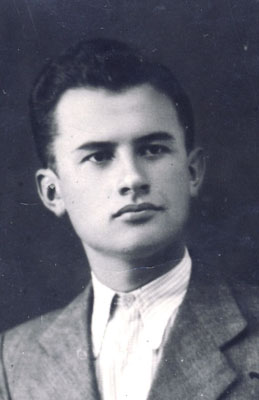
Ion Vincze was a Romanian communist politician and diplomat. An activist of the Romanian Communist Party (PCR), he was married to Constanța Crăciun, herself a prominent member of the party.
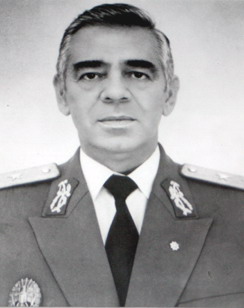
Ștefan Gușă or Gușe was a Romanian general who was the Chief of the General Staff of the Romanian Armed Forces between 1986 and 1989.
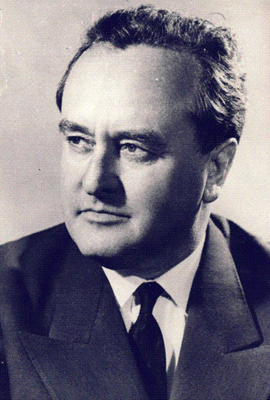
Avram Bunaciu was a Romanian communist politician and jurist who served as the Minister of Justice, Minister of Foreign Affairs and in March 1965 was for 5 days the acting President of the State Council of Romania.
Parliamentary elections were held in Romania on 17 March 1985. The Front of Socialist Unity and Democracy (FDUS), dominated by the Romanian Communist Party (PCR) and including other mass organisations, was the only group to contest the elections, and no prospective candidate could run for office without the Front's approval. Consequently, FDUS candidates won all 369 seats in the Great National Assembly, also ensuring the rubber-stamp confirmation of Nicolae Ceaușescu as President of Romania. The Assembly which elected him included several members of the Ceaușescu family, namely his wife Elena, son Nicu, and brother Ilie. Continuity was also ensured by other incumbents, including Nicolae Giosan as Assembly chairman and Constantin Dăscălescu as Prime Minister.

Emil Bobu was a Romanian Communist activist and politician, who served as Interior Minister from 1973 to 1975 and as Labor Minister from 1979 to 1981. He was an influential figure in the later years of the Communist regime until his downfall during the 1989 Revolution.
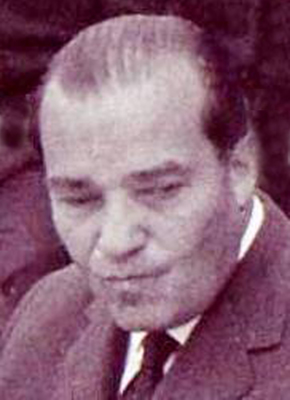
Alexandru Bârlădeanu was a Romanian Marxian economist and statesman who was prominent during the communist regime until being sidelined in 1968. In his later years, following the collapse of the regime, he served as Senate President.

Nicolae Militaru was a Romanian soldier and communist politician. Rising to the rank of general by the 1960s, his ties to the Soviet Union led dictator Nicolae Ceaușescu to question his loyalty and sideline Militaru in 1978. He re-emerged during the Romanian Revolution, when he was made Defense Minister, serving for nearly two months before street pressure forced his dismissal. Days after Ceaușescu’s execution, he was advanced to general of the army. His final public act came in 1996, when Militaru ran for President, barely registering any support.
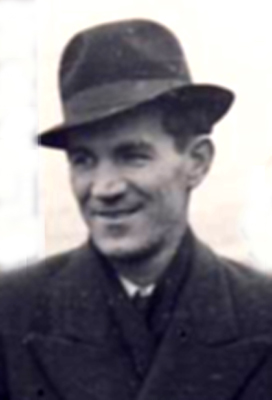
Constantin Doncea was a Romanian communist activist and politician. A railway worker, he played an important part in the Grivița Strike of 1933. Subsequently, imprisoned, he escaped and ended up in Moscow. He then joined the International Brigades during the Spanish Civil War. After spending much of World War II in the Soviet Union, he returned to Romania, where he helped establish a Communist regime. Doncea held a series of posts under the new order, but in 1958 he was removed from the party after clashing with its leader Gheorghe Gheorghiu-Dej. In his later years, he was rehabilitated by the latter's successor, Nicolae Ceaușescu.

Vasile Patilineț was a Romanian communist activist, politician and diplomat. A worker and native of the industrial Jiu Valley, he joined the Romanian Communist Party in 1945 and steadily rose through its ranks, entering the central committee a decade later. Subsequently, he became a close ally of Nicolae Ceaușescu, whose rise to power in 1965 he helped facilitate. A significant player in the early years of the latter's rule, he became steadily alarmed by the dictator's excesses and began plotting against him by the late 1970s. He was sent as ambassador to Turkey in 1980, and six years later, upon finishing his service at Ankara, was killed in a suspicious car accident.
Marțian Dan was a Romanian politician and university professor.
The second cabinet of Constantin Dăscălescu was the government of Romania from March 29, 1985, to December 22, 1989. It resigned in the aftermath of the Romanian Revolution. Four days later, it was succeeded by the First Roman cabinet.

















